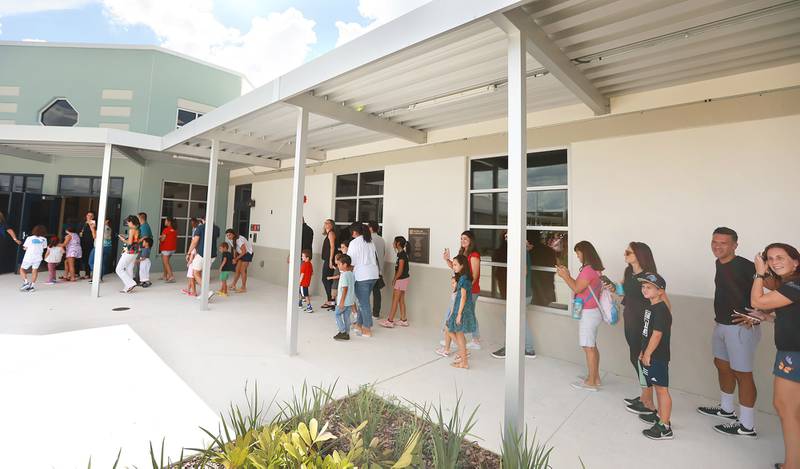
School’s back with not enough teachers or bus drivers and safety concerns
Orlando Sentinel | By Leslie Postal | August 9, 2022
Central Floridaschool leaders hope the new year that starts Wednesday is unremarkable, without the COVID-19 disruptions that marred the past two. But they know the 2022-23 academic year faces its own challenges.
Public schools are starting classes without enough teachers or bus drivers, so in Orange County, some teenagers will be dropped at their campuses as early as 6:30 a.m., and elementary and middle school bus riders will be transported home later than usual.
New state laws focused on curriculum, school books and parent rights won applause from supporters of Gov. Ron DeSantis, but they make many educators uneasy. One of them will alter visits to school health clinics, with Seminole County Public Schools announcing this week that nurses will no longer offer students ice packs, among other routine treatments, without prior parental consent.
In the wake of the shooting tragedy at a school in Uvalde, Texas, campus safety remains a top-of-mind priority. This year, school employees will have “panic buttons,” though the new requirement is not fallout from the Texas shooting but from the 2018 high school massacre in Parkland.
Despite the worries, educators hope the year begins with all the traditional excitement over carrying new backpacks, meeting new teachers and making new friends.
To set that stage, Orange County Public Schools, which will open five new campuses Wednesday, gave excited parents and students “sneak peeks” of those facilities last week. In Osceola County, Superintendent Debra Pace planned to read a “bedtime story” via Facebook to students Tuesday night, ahead of the first day.
“We’re ready to start off a great new year,” said Teresa Jacobs, chair of the Orange County School Board, during a back-to-school press conference Monday.
:quality(70)/cloudfront-us-east-1.images.arcpublishing.com/tronc/UVI3AM3LYNBBBJQHFQYML7BQXM.jpg)
Staff shortages abound
After the pandemic canceled classes, forced online learning and led to sky-high absentee rates, school administrators hope this year they can help get struggling students back on track.
“We will remain focused on supporting our students who experienced the pandemic slide,” said Seminole Superintendent Serita Beamon at a press conference on Friday.
That means they want regular attendance to matter again. “Getting back into the habit of daily attendance matters more than ever as we recover from two years of absences and disruptions caused by the pandemic,” read a back-to-school Facebook message from the Lake County school district.
But all Central Florida school districts still need teachers,with Osceola schools alone reporting more than 230 vacancies on Tuesday, as do public schools across the state. The Florida Education Association counted about 8,000 teacher vacancies statewide in late July.
OCPS needs about 100 teachers, a “slightly higher” vacancy rate than it faced last year at this time, said Maria Vazquez, the deputy superintendent tapped in late June to become OCPS’ next leader.
The district increased its teaching staff last year, using federal relief money to hire “intervention teachers” to help students catch up, so part of the issue is the need for more instructors. But morale problems, prompted in part by new state laws, are to blame for the hiring crunch, too, Vazquez said.
Central Florida administrators, while busy recruiting new teachers, plan to use long-term substitute teachers and assign district staff back to classrooms to fill in the gaps.
Districts also need more bus drivers, with 84 jobs still vacant in Seminole as of Friday.
In Orange, school leaders decided to handle the shortage by having drivers do two runs to the high schools in the morning, dropping off one group of teenagers on campus at 6:30 a.m. then going out to get a second group to be dropped at school by 7 a.m., said Bill Wen, OCPS’ senior director for transportation.
The drivers also will do two high school runs in the afternoon, a change that will push back by 35 minutes the usual end-of-day departure time for bus riders in elementary and middle schools.
“I know it is not ideal,” Wen said.
But at least under this plan — one he said districts nationwide are trying — buses should arrive on schedule at the bus stops, even if earlier in the morning or later in the afternoon than students and parents would like. Last year, buses often ran late because there weren’t enough drivers, leaving children and parents waiting and frustrated.
“It will help us control the chaos,” Wen added.
DeSantis-backed laws kick in
New state laws championed by DeSantis give parents more power to scrutinize classroom and library books, ban the teaching of “critical race theory” in all grades and prohibit the teaching of sexual orientation and gender identity in primary grades.
They worry some educators who fear the new laws are making teachers unsure what they can say in class about race, LGBTQ issues and other sensitive topics and making some students feel unwelcome.
“Every one of our students, no matter their race, gender or background, will be supported by our school board and by our district,” Vazquez said, in a nod to those worries.
State GOP leaders call those fears unwarranted and are defending the new laws, which face legal challenges.
Whatever the outcome of lawsuits and its influence in classrooms, the Parental Rights in Education act— one of the controversial bills derided by critics as the “don’t say gay” measure — already has an immediate and bureaucratic impact on thousands of parents who must now sign consent forms, if they want schools to provide routine care to their sick or injured children on campus.
Supporters of the law said it rightly gave more power to parents to determine health care services for their children. That part of the bill aimed, DeSantis said, to make sure schools did not, in the case of children who say they are non-binary or transgender, “support transitioning students without parental knowledge and consent.”
But it impacts far broader services.
“Parents must now provide affirmative consent for schools to provide health care services to minor students,” reads a Monday letter sent out by Seminole schools to parents. “This means that a service that we routinely provided in the past such as rendering an ice pack, band aid or taking a student’s temperature can no longer take place on the school campus without parental consent on file.”
Other districts provided similar messages and forms for parents to provide consent for health services. Schools will still provide emergency care to students but without signed consent forms will call parents to pick up their children in cases of illness or minor injuries, officials said.
‘Active assailant’ training
The shooting at Robb Elementary School in Texas on May 24 took the lives of 19 students and two teachers and prompted fierce criticism of the police response after it was revealed officers waited more than an hour before entering the classroom where the gunman was and killing him.
Fear of another school shooting remains on educators and officers’ minds, and both law enforcement agencies and school districts provided “active assailant” trainings this summer.
In Orange, Sheriff John Mina said his office’s training sessions at a local high school focused on how officers should respond.
“They’re going to go in and end the threat immediately and save lives,” said Mina, part of a team tapped by the U.S. Justice Department to review the police response in the Texas massacre.
“We’re all mindful to do all that we can,” said Seminole Sheriff Dennis Lemma at the Friday press conference in his county, adding that “going in and neutralizing that threat” was key.
Across the region, school employees this year will have new “panic buttons” on their badges, laptops or phones that can be used to silently summon help in an emergency.
These are a requirement of “Alyssa’s Law,” named for Alyssa Alhadeff, one of the victims in the shooting massacre at Marjory Stoneman Douglas High School.





